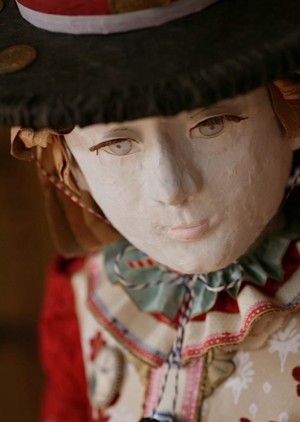Artist of the Week 12/12-12/18: Patty Grazini and the Life of the Giantess
GALO: Your Web site states your art focuses on the “beauty and mystery of recapturing forgotten moments and scenes from history. The distance of time passed is diminished through the retelling of stories, from the quotidian to the macabre.” Could you elaborate a little bit on this?
PG: There is so much mystery in looking at an old photograph or reading a piece of historical writing. Although it is impossible to truly know the emotions, and the life of a 17-year-old giantess living in the late 1880s, I have attempted to scratch the surface. I would like the viewer to have an entry into her world through my artwork. I research my subjects carefully, wanting to shorten the distance of time passed.
GALO: Before The Life of the Giantess, you did a series inspired by real people who committed crimes as reported in the New York Times between 1885 and 1915. Thirteen sculptures between 12 and 14 inches high were created, and accompanying each piece was a copy of the original article about the person. What’s the story behind that series?
PG: I researched the New York Times, looking for people who had committed crimes during this time. This was during the time of great immigration into our country. It was also the time of the greatest wealth and greatest poverty. Corruption was everywhere. It was a fascinating time period and I wanted it to be shown through the crimes of this time. I chose 13 people to portray, each committing a different kind of crime. The crimes were varied: a child shoplifter who stole a bolt of ribbon, an underage opium smoker, and a vendor who painted sparrows yellow and sold them as canaries.

A piece created by Patty Grazini depicting a gift given to Elizabeth Lyska by an unknown Russian admirer. Photo Courtesy of: Patty Grazini.
GALO: One of the interesting aspects of the series on the criminals is that none of them have human heads. For example, the knife thrower is a sewer rat, the 16-year-old opium smoker is a sheep, and the woman polygamist is portrayed as a crow as she gathers keys and husbands. Why the animalistic motif, and how did you determine which animal to associate with each person?
PG: I wanted to give the criminals heads of animals for various reasons. I chose animals that represent human traits to reveal more about the criminal and their crime. Also, there is an added element of mystery using animals. The viewer is drawn in and wants to know more about the subject and their animal portrayal. Another reason was that political cartoonists often used the heads of animals in their cartoons during the Victorian Age, which I wanted to reference.
GALO: What are some particular challenges you face working with paper that you wouldn’t working with, say, clay? Have you ever used other mediums or thought about it?
PG: I’ve worked in several different mediums, but primarily fabric, making wearable art. Most people think of paper as flat and somewhat rigid. My approach using paper is very much like cloth. Paper can be gathered, pleated and dyed as with fabric.

A piece created by artist Patty Grazini for “The Life of the Giantess” exhibit. Photo Courtesy of: Patty Grazini.
GALO: You collect paper from various sources, such as bookstores and abandoned corners, for your work. In the past, you’ve stressed the importance of knowing the “story” behind the paper you use. What do you mean by that?
PG: I prefer using paper that is from the time period in which I am working, as a sort of way to bridge time. It isn’t always possible of course, but I always try to relate to my subject through the paper as well. Often, it is not in an obvious way. For the giantess, I cut apart a printed book in Russian and used small pieces as decorative elements on her apron and skirt. If very carefully examined, the viewer may or may not discover the paper.
GALO: You’re based out of Seattle. Does the environment of the Pacific Northwest serve as an influence in your work at all? And does the famous Seattle rain complicate the task of collecting paper for your sculptures?
PG: The colors of the Northwest are influential in my work. I prefer muted colors that look as though washed by the rain. I collect much of my paper while traveling.

(L-R) A close-up of Elizabeth Lyska’s 4-foot tall assistant and a toy poodle given to Elizabeth Lyska as a gift by the French painter Louis Anquetin, created by Patty Grazini. Photo Courtesy of: Patty Grazini
GALO: With so much emphasis on the electronic medium these days and its impact on papermaking (i.e., e-books replacing traditional hardcovers, newspapers going digital only, etc.), do you think people sometimes “forget” paper? Why might it be important to remember the medium?
PG: It does concern me that people will forget how it feels to hold a book, or the smell of a library of old books. I have a French letter written in 1699, a bound volume of Seattle newspapers from the Klondike Gold Rush, and a Ukrainian family bible from the late 1800s. There is really something quite wonderful for me to hold these, and think about whose eyes viewed them before, what they might have worn, and how they would have felt.


